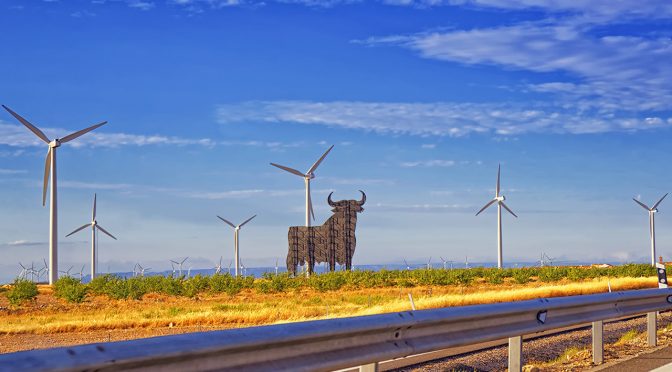Wind energy generated 27.8% in November, photovoltaic 5.8% and concentrated solar power thermal 0.8%. The demand for electricity in Spain rises 4% in November. 41.7% of the monthly generation was of renewable origin and 57.2% was produced from technologies that do not emit CO2 equivalent. The demand for electrical energy increases 12% in the Balearic Islands and 9.1% in the Canary Islands compared to November 2020.
The national electricity demand for last November is estimated at 21,517 GWh, 4% more than that registered in November 2020. If the effects of the calendar and temperatures are taken into account, the figure is 1.4% higher than to the same month of the previous year.
National demand for electricity in November 2021
Compared with a period prior to the pandemic (November 2019) and corrected for the effects of employment and temperatures, the demand for national electricity decreased by 2.3%.
In the first eleven months of 2021, the demand is estimated at 234,413 GWh, a% more than in the same period of 2020. Once the influence of the calendar and temperatures has been corrected, the demand is 2.9% higher.
In November, and according to data estimated to date, generation from renewable energy sources represented 41.7% of the mix. During this month, green energy production was 9,636 GWh, 19.4% more than in the same period in 2020.
With the information available today, wind power has grown by 52.6% compared to November 2020, and it is the technology that has contributed the most GWh to the national mix this month, specifically, 27.8% (6,426 GWh). The combined cycle is the second generation source for November, with 6,415 GWh.
Nuclear power, with 15.5%, is the third that has produced the most, followed by cogeneration which, with 2,184 GWh generated in November, is fourth in the mix with a 9.4% share.
For its part, solar photovoltaic has generated 1,334 GWh, which is 63.9% more than in November 2020. Its contribution to the national mix has been 5.8%.
In this month of November, 57.2% of electricity production came from technologies that do not emit CO2 equivalent (greenhouse gases).
Power generation mix November 2021
The demand for electrical energy rises 3.6% in the peninsular electrical system
In the peninsular electricity system, the demand for this month is estimated at 20,364 GWh, 3.6% higher than that registered in November 2020. If the effects of the calendar and temperatures are taken into account, the demand is 1% higher than the same month of the previous year.
Compared with a period prior to the pandemic (November 2019) and corrected for the effects of labor and temperatures, the demand for electricity on the peninsula decreased by 2.3%.
From January to November 2021, the demand for electricity in the Peninsula is estimated at 221,609 GWh, 2.9% more than in the same period in 2020. In this case, once the influence of the calendar and temperatures has been corrected, demand is 2.8% higher.
During the month of November and according to data estimated to date, 43.2% of the peninsular generation was of renewable origin and 59.5% came from technologies that do not emit equivalent CO2. For its part, wind energy registered 6,332 GWh, 52.4% more than the production of November last year, and solar photovoltaic 1,310 GWh, 65.7% more than in the same month of 2020.
The demand for electricity increased by 12% in the Balearic Islands and 9.1% in the Canary Islands in November
In the Balearic Islands, the demand for electricity this month is estimated at 408,099 MWh, 12% higher than that registered in November 2020. If the effects of the calendar and temperatures are taken into account, the demand increases by 7, 3%.
Compared with a period prior to the pandemic (November 2019) and corrected for the effects of employment and temperatures, the demand for Balearic electricity decreased by 0.8%.
In the first eleven months of 2021, Balearic demand is estimated at 5,090,600 MWh, 13% more than in the same period of 2020.
The combined cycle, with 81.6% of the energy produced in the Balearic Islands, was the archipelago’s main source of electricity generation in November, followed by diesel engines (4.8%). This month, the renewable energy that does not emit CO2 equivalent (greenhouse gases) generated in the Balearic community represents 6.1% of the total.
In addition, during this month, the electrical energy from the submarine link between the Peninsula and Mallorca covered 6.9% of the Balearic electricity demand.
On the other hand, in the Canary archipelago the demand for electricity is estimated at 711,730 MWh, 9.1% higher than that registered in November 2020. If the effects of the calendar and temperatures are taken into account, the figure increases by 9.4%.
Comparing it with a period prior to the pandemic, the month of November 2019, and after correcting the effects of employment and temperatures, the demand for Canarian electricity decreased by 3.1%.
In the first eleven months of 2021, Canarian demand is estimated at 7,343,646 MWh, 0.9% more than in the same period in 2020.
The combined cycle, with 46.1% of the total, was the first source of electricity generation in November, while renewables and technology


